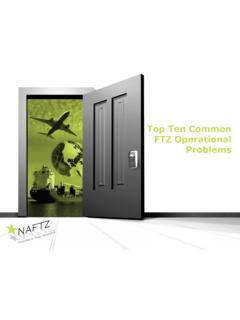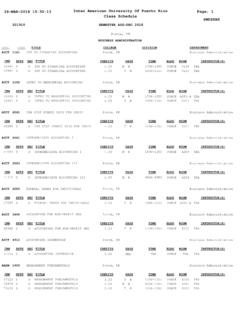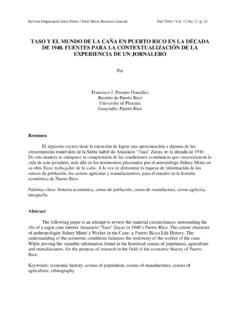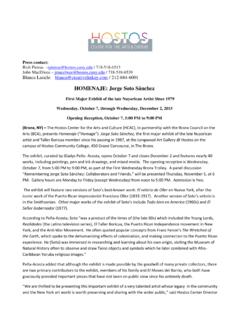Transcription of The impact of Foreign-Trade Zones on the 50 …
1 The impact ofForeign-TradeZoneson the 50 states & puerto RicoNational Association of Foreign-Trade ZonesFY 2009 The impact of Foreign-Trade Zones on United States and puerto rico provides a state-by-state breakdown of Foreign-Trade activity in the 2009 fiscal year.* Each of these state analyses give special attention to the factors reflecting Foreign-Trade zone growth: annual merchandise volume, exports, employment, and business firm engagement. These statistics are extracted from the required Annual Reports submitted by each Foreign-Trade zone to the Foreign-Trade Zones Board in the Department of Commerce. These reports are public goal of this study is to increase public awareness of Foreign-Trade zone activity, and the roles Foreign-Trade Zones play in each state s economy.
2 Although the Foreign-Trade Zones program is not large in scale, the statistical and qualitative detail of this report underscores the important role that Foreign-Trade Zones play in and international trade . It also facilitates a year-over-year comparison and assessment regarding program the material presented for each state, Chart 1, entitled Foreign-Trade Zones and Subzones, defines annual volume as the currency value of received merchandise, both domestic and foreign , and includes zone-to-zone transfers to provide a complete picture of the business conducted in each zone. Exports are regarded as the currency value of all goods that leave the Foreign-Trade zone directly without entering commerce, regardless of origin before admission into the zone.
3 Employment includes all persons engaged in business activities under zone procedures, including contract workers and part-time employees reported by zone grantees. Active firms reflect the total number of firms served by the zone over the course of the fiscal members of the National Association of Foreign-Trade Zones have supported this report in an effort to encourage a greater understanding of Foreign-Trade Zones and their role in national and local economic statistical analysis in this report was created by John Liszewski, a Master of Arts recipient from the Edmund A. Walsh School of foreign Service at Georgetown University and Research Analyst for the National Association of Foreign-Trade Zones .*The fiscal year began on October 1, 2008 and ended on September 30, This ReportForeign- trade Zones (FTZs) were created to provide special Customs and Border Protection (CBP) procedures to firms engaged in international trade -related activities.
4 FTZ procedures were designed to promote manufacturing in domestic industries and to encourage the export of assembled products. FTZs consist of General-Purpose Zones (GPZs), which typically maintain multiple user firms and are utilized primarily for warehousing and distribution. FTZs may contain subzones, which serve a single company s manufacturing operations. The FTZ program requires that subzones serve the public interest and produce a net positive economic effect. This study provides valuable insight into how FTZs encourage domestic job creation, promote employment retention, encourage international trade , and positively impact economic development on the state and local level. The Great Recession of 2007-2009 had a negative impact on business activities in FTZs across the country, as the majority of annual volume, export and employment figures dropped significantly from 2008 to 2009.
5 These negative trends were mainly due to a reduction in demand for both industrial goods and consumer products as well as a decline in world oil prices. Nevertheless, the difficult economic conditions incited some businesses to take advantage of FTZs and their potential to create substantial savings by allowing companies to defer, reduce or eliminate tariff payments on foreign and domestic merchandise received into Zones . During FY2009 the pharmaceutical, automotive, and oil industries were the primary beneficiaries of the FTZ program, with many businesses performing manufacturing, warehousing and distribution operations under zone procedures. Zones in 10 states had an average increase in annual volume of 5% or more. Additionally, Zones in 7 states had an average increase of 5% or more in Volume in 2009 The combined value of merchandise shipments into Foreign-Trade Zones (both GPZs and subzones) amounted to $456 billion in FY2009.
6 This amount of business activity, which was measured in dollars, represented a 39% decrease over the $747 billion in zone receipts reported by the NAFTZ for FY2008. The general decrease in annual volume handled by FTZs was primarily attributed to the global economic recession and the subsequent drop in world oil prices. If we exclude the oil producing states of Texas, Louisiana, Alaska, and California, the total annual volume for FY2009 would amount to $197 billion. However, this number would still reflect a 55% decrease over annual volume in FY2008. Exports to foreign Countries The exports from Foreign-Trade Zones to foreign countries totaled $28 billion in FY2009. These export figures show a 32% decrease from the $40 billion in zone exports for FY2008.
7 The total value for exports of manufactured commodities from fell 20% during the 2008-2009 In FY2009 Foreign-Trade Zones employed 330,933 persons. The FY2009 figure represented a 6% decline from a total of 350,282 FTZ employees in FY2008. The NAFTZ worked to ensure the accuracy of zone employment reporting, particularly for part-time and contract labor. Firms Engaged in Zone Activities There were 2,523 active firms served by Foreign-Trade Zones in FY2009. This figure represented a 1% increase from the 2,509 active firms served in FY2008. A number of firms located in activated Zones do not use zone procedures, though they would like to maintain this option for the future. The Big Picture 2009 The National impact of the Foreign-Trade Zones Program*These figures include only active General-Purpose Zones and Subzones for Zone LocationsThere were 132 General Purpose Foreign-Trade Zones & 261 Subzones* in the by Foreign-Trade Zones StateAnnual Volume ($ millions)Texas138, , , , , , Jersey18, , , , Carolina10, Rico10, , , , of Foreign-Trade ZonesStateEmploymentTexas51,394 Ohio35,534 Pennsylvania19,939 California19,220 Kentucky19,145 Louisiana17,498 Illinois17,439 Mississippi16,126 New Jersey15,987 Arizona14,253 Michigan11,134 puerto Rico11,126 Alabama9,766 South Carolina8,549 Tennessee8,253 Exports from Foreign-Trade Zones StateAnnual Volume ($ millions)
8 Texas5, Carolina3, , , , , , Rico1, , of Firms Actively Engaged in Foreign-Trade ZonesStateBusiness FirmsTexas425 California291 Florida242 Hawaii239 Ohio171 New York123 South Carolina118 puerto Rico102 Maryland92 Louisiana90 Nevada87 Illinois75 Tennessee60 Michigan56 Georgia50 Top 15 State Ranking 2009 Annual Volume and Exports (Alabama 2008-2009) Employment State EmploymentForeign- trade Zones : 5 Annual Volume: $ billionExports: $ billion Employment: 9,766 Alabama Foreign-Trade Zones and Subzones FTZ Location EmploymentAnnual Volume($ millions)Exports($ millions)Active FirmsActive SubzonesNo. 82 Mobile3,3421, 98 Birmingham3,3252, , 222 Montgomery2,8372, ,7667, , : 2009 Annual Reports submitted by grantees to the Foreign-Trade Zones Board, Department of : All categories include both general purpose and subzone activity.
9 Annual volume is considered to be received merchandise from the FTZs, including goods of domestic origin and foreign status, as well as zone-to-zone transfers. *Exports of manufactured commodities below are as reported by the foreign trade Division, Census DevelopmentThe volume of Foreign-Trade Zone (FTZ) activity in Alabama decreased from $ billion in 2008 to $ billion in 2009. Exports from Alabama FTZs decreased from $ billion in 2008 to $ billion in 2009. Export of manufactured commodities from Alabama decreased during the 2009 calendar year.*Jobs associated with Alabama FTZs decreased amounting to 9,766 in 2009. In contrast, total nonfarm employment in Alabama decreased during the 2009 calendar year.
10 Active Firms: 21 Active Subzones: 8 Source: Foreign-Trade Zones Board, Department of Commerce; and Department of Labor, Bureau of Labor ,0004,00010,0006,0008,00012,00014,000 Annual VolumeExports20082009 Employment Percentage Changes (Alabama 2008-2009)$ millionsNo. 82 Mobile, AlabamaFTZ No. 82 maintained 5 subzones and served 12 businesses engaged in shipbuilding, ship repair, oil refining, and the production of magnetic recording, chemical as well as petrochemical products. During the economic recession of FY2009, annual volume declined , exports fell and employment dropped No. 83 Huntsville, AlabamaFTZ No. 83 maintained 0 subzones and served 2 businesses. Annual volume decreased , from $ million in FY2008 to $ million in FY2009.






